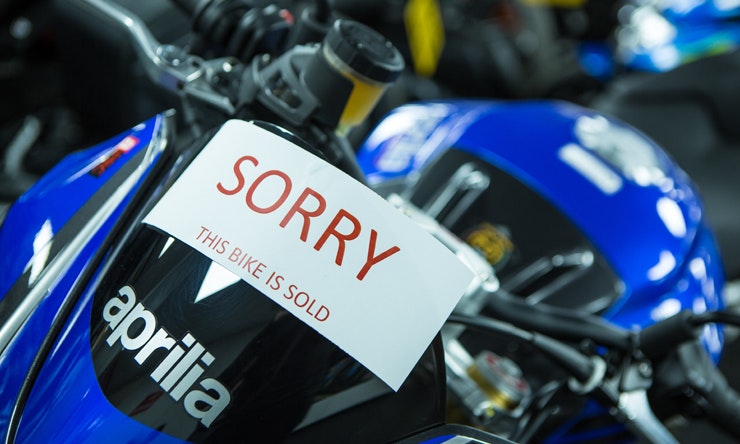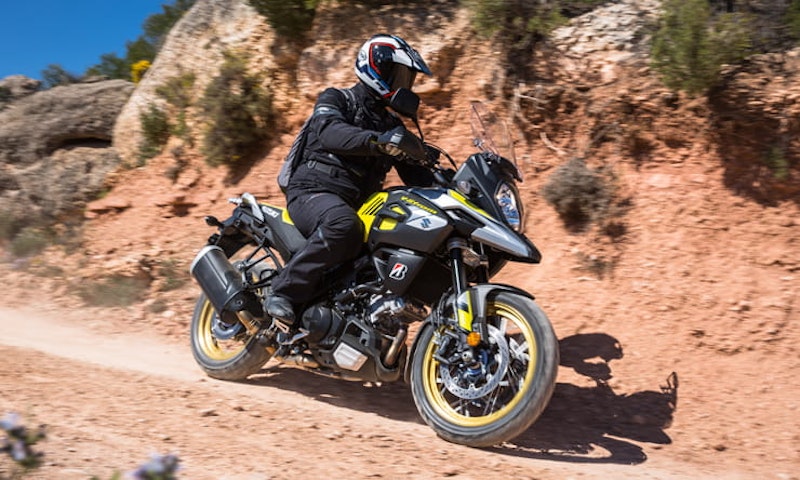Which used bikes are your local showrooms about to be full of?
By Ben Purvis
Motorcycle Journalist
08.05.2018
There’s no question that the biggest change in the way people buy bikes over the last decade or so has been the PCP (personal contract purchase) deal.
You’re probably familiar with the concept. Instead of stumping up the whole price up front or taking out a traditional HP finance deal where you spread the purchase cost over a few years, PCP radically reduces monthly payments and usually allows for surprisingly small deposits.
Unlike a loan or an HP deal, a PCP plan predicts the second-hand value of the bike at the end of the deal – normally two or three years – and defers that value to the end of the arrangement. So you’re basically simply paying for the depreciation, along with interest on the loan. That interest isn’t calculated on the entire value of the bike, but just on the difference between the purchase price and the GFMV (Guaranteed Future Motorcycle Value), which again helps keep payments down.
Low interest rates – as we’ve generally seen in this country ever since the 2008 financial crash – make PCP all the more enticing. Zero percent interest deals are rife, meaning your payments are simply covering the depreciation of the bike alone.
At the end of the deal, PCP gives three choices. You can opt to pay the lump sum, known as the ‘guaranteed minimum future value’ (GMFV), as though you were simply buying your own bike as second-hand machine. Alternatively you can trade it in against a brand new machine – the GMFV is usually below the actual used value of the bike, so any surplus between your bike’s real value and its GMFV hopefully covers the deposit on the new model. Or, finally, you can simply hand the bike back to the dealer and walk away.
The reality is that virtually nobody opts for the first option of paying that GMFV lump sum and taking permanent ownership of their bike. Having got used to paying a monthly sum, it’s all too tempting to chop it in against the latest, greatest new model.
And that means it’s easier than ever to predict what bikes will be in ready second-hand supply at a particular time. By looking back at the top selling machines from 2015 and 2016, we can take a stab at seeing which machines are likely to be reaching the end of their two or three year PCP arrangements and getting handed back to dealers this spring.
Looking at figures from the Department for Transport, we can tell that the two- and three-year marks are key. In 2017 there were 103,800 new bikes registered in the UK. By the end of the year, 90,100 of those were still with their first keeper and 13,000 were onto their second keeper. In reality most of those two-keeper bikes were probably pre-registered by dealers and sold as ex-demo machines. Quite how 700 bikes managed to be onto their third keeper in under a year is a mystery…
The same figures show that at the end of 2017, some 62.8% of surviving bikes registered in 2016 were still in the hands of their first owner.
At the same moment, the end of 2017, 49.3 % of 2015-registered bikes were still owned by their original buyer, and only 35.9% of 2014 models were one-owner bikes. So by the time bikes reach their third birthday, only around half are still with their original buyer, and before they hit four that drops to around a third.
While we could look back to the sales charts for 2015 and 2016 to see what bikes were most popular back then, and extrapolate from those figures which models are most likely to come up for sale as they hit three-years-old, the DfT actually makes it easier than that.
Government figures actually list, by make, model and year of registration, exactly how many bikes were licenced and on the road at the end of 2017. That means we know not only how many were originally sold, but how many of each model have survived to see their second and third birthdays.
The top 10 most 2015 models still on the road at the end of 2017 were:
Honda PCX125 – 1581 remain from 2091 registered in 2015. Survival rate: 75.6%
Honda Vision 110 – 1314 remain from 1565 registered in 2015. Survival rate: 83.9%
Yamaha MT-09 Tracer ABS – 1252 remain from 1517 registered in 2015. Survival rate: 82.5%
Honda CB125F – 1164 remain from 1457 registered in 2015. Survival rate: 79.9%
BMW R1200 GS – 1125 remain from 1411 registered in 2015. Survival rate: 79.7%
Yamaha MT125 ABS – 1062 remain from 1473 registered in 2015. Survival rate: 72.1%
BMW R1200 GS Adventure – 1006 remain from 1290 registered in 2015. Survival rate: 78%
Yamaha MT-07 ABS – 983 remain from 1213 registered in 2015. Survival rate: 81%
Honda CBR125R – 862 remain from 1235 registered in 2015. Survival rate: 69.8%
Yamaha YBR125 – 791 remain from 1098 registered in 2015. Survival rate: 72%
For comparison, of all the 105,500 registered in 2015, 79,900 remained at the end of 2017. That’s a survival rate of 75.7%. However given that the figures above are a snapshot taken at the end of 2017, in winter, there are bound to be a proportion of roadworthy bikes that are hidden away in garages with a SORN rather than being licenced, which could skew the survival rate figures.
Given that those are the 10 most common surviving 2015 models, it’s fair to assume that as they hit the three-year-old mark during 2018, they’re likely to represent a big slice of second-hand stock.
It’s worth remembering that bikes subject to PCP deals will inevitably end up back at main dealers; either the original selling dealer or, if the buyer is trading in for another brand, at a rival company’s showroom. They’re much less likely than in the past to end up at independent used bike showrooms.
It’s for that reason that you won’t necessarily find that prices for the most common second-hand models are the lowest. One of the clever parts of the PCP system is that as deals come to an end, the used stock is generally channelled back through the dealers of the companies that originally sold the bikes when they were new. That means those dealers have a strong influence over the second-hand pricing. If they can keep used bike prices high, it means PCP deals on new stock will be all the more tempting. Not only will the difference between new and used be less, but it means they can offer an increased GMFW, effectively reducing the depreciation that makes up the lion’s share of PCP monthly payments.
Since two-year PCP deals are also commonplace, now we’ll have a look at the equivalent figures for 2016 bikes.
The top 10 2016 models still licenced for road use at the end of 2017 were:
Honda CB125F – 1870 remain from 2242 registered in 2016. Survival rate: 83.4%
Honda Vision 110 – 1515 remain from 1672 registered in 2016. Survival rate: 90.6%
BMW R1200 GS Adventure – 1284 remain from 1531 registered in 2016. Survival rate: 83.9%
BMW R1200 GS – 1191 remain from 1476 registered in 2016. Survival rate: 80.7%
Yamaha NMax 125 ABS – 1171 remain from 1391 registered in 2016. Survival rate: 84.2%
Honda PCX125 – 1128 remain from 1396 registered in 2016. Survival rate: 80.1%
Yamaha MT-07 ABS – 1051 remain from 1277 registered in 2016. Survival rate: 82.3%
Yamaha MT125 ABS – 1020 remain from 1298 registered in 2016. Survival rate: 78.6%
Yamaha MT-09 Tracer ABS – 918 remain from 1061 registered in 2016. Survival rate: 86.5%
Yamaha YZF-R125 ABS – 864 remain from 1230 registered in 2016. Survival rate: 70.2%
There were some 114,800 bikes registered in 2016, and 98,400 of them remained on the road at the end of 2017, so the average survival rate is 85.7%. Again, the above survival rates don’t take SORN’d survivors into account.
What can we tell from all this?
Well, dealers should be overflowing with second-hand BMW R1200GS and R1200GS Adventures – which comes as little surprise given they’ve been the best-selling large bikes in this county for years now.
However, that’s been the case for a long time; the water-cooled GS that’s still topping the sales charts today is largely the same model that was first introduced in 2013, albeit with minor tweaks and a facelift over the intervening years.
Perhaps more important if you’re shopping the used market are the machines that are only just reaching the 3-year-old mark. The Yamaha MT-09 Tracer, for instance, has been a runaway success since its launch in 2015, but the majority will have remained in the hands of their original owners until now. However, with their first MOTs approaching fast a lot of those 2015 models will be reaching the end of their PCP arrangements soon, so you should expect an ever-increasing choice of them on the used market. The same applies to the MT-07, which went on sale in 2014 but had its first full year of sales in 2015.
Just as popularity means that some bikes will become easier to find on the used market soon, that have faded from fashion among new bike buyers two to three years ago will be hard to get your hands on. Anyone looking for a two or three-year-old 600cc supersports bike might have noticed that used prices are pretty strong at the moment. A 2015 CBR600RR, Yamaha R6, Suzuki GSX-R600 or Kawasaki ZX-6R could easily set you back £7000-£8000; not a huge amount less than they cost when they were new.
That reflects the fact that so few have been registered over the last three years or so, making them relatively hard to find in second-hand form.
But popularity props up prices even among more common bikes, too. The BMW R1200GS, as the perennial number one seller, holds its value ridiculously well; a three-year-old bike is unlikely to be less than £11,000 in a dealer, and the base price of a brand new one is little more than that at £12,400. It’s that slow loss of value that allows the tempting PCP deals to exist.
If you’re hunting for a bargain, then, it might be an idea to stray from the more obvious path. A Suzuki V-Strom 1000 from 2015 might be yours for £6000 on the used market, and even Triumph’s GS-rivalling Tiger Explorer can be found for as little as £8000 for a three-year-old example.
Share on social media:

